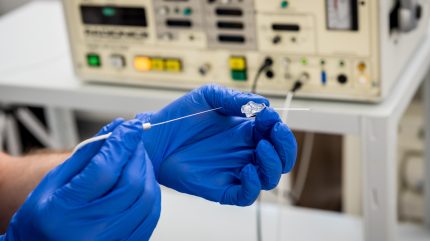
Metabolic diseases, including type 2 diabetes, present significant challenges for patients and healthcare systems worldwide. These conditions often require lifelong management involving medications, lifestyle changes, and frequent monitoring.
Type 2 diabetes prevalence typically increases with age. According to GlobalData figures, 2.4% of men and women aged 30-34 were diagnosed with type 2 diabetes globally in 2024. In men and women aged 75-79, this increased to 15.58% during the same year. All diagnoses are projected to increase across all age groups by 2028. In the US, the type 2 diabetes market was worth $43.49bn in 2024, according to GlobalData figures. By 2029, this is projected to rise to $57.23bn.
However, an innovative endoscopic procedure known as duodenal mucosal resurfacing (DMR) offers new hope for patients. This minimally invasive treatment targets abnormalities in the gut, offering patients a way to regulate glucose and cholesterol levels, reduce liver fat, and achieve weight loss. With its potential to improve metabolic health significantly, DMR is revolutionising care for patients with these chronic conditions.
What is duodenal mucosal resurfacing?
The duodenum, the first part of the small intestine, plays a crucial role in nutrient absorption and metabolic regulation. In patients with metabolic diseases, the duodenal lining often becomes dysfunctional, contributing to insulin resistance and other metabolic imbalances. Duodenal mucosal resurfacing addresses this by using an endoscopic ablation catheter to rejuvenate the mucosal lining and restore its proper function.
During the procedure, a flexible catheter is inserted through the patient’s mouth and guided to the duodenum. The device delivers precise heat bursts to the mucosal lining, ablating the dysfunctional tissue. This triggers a natural regeneration process, encouraging the growth of healthy cells and resetting the duodenum’s metabolic activity. The entire procedure is performed on an outpatient basis and typically takes less than an hour, with patients often resuming normal activities within a few days.
Clinical trials have demonstrated that DMR can lead to significant improvements in metabolic health. Patients undergoing the procedure frequently experience better glycaemic control, with reductions in HbA1c levels – a key marker of blood sugar management. Additionally, DMR has been shown to lower cholesterol levels, decrease liver fat, and support weight loss, making it a comprehensive treatment for metabolic dysfunction. These benefits extend beyond glucose control, offering a holistic improvement in patients’ overall health.
Variations in ablation DMR treatments for type 2 diabetes include hydrothermal ablation, a minimally invasive heat-based procedure. Another promising treatment is circumferential radiofrequency vapor ablation for duodenal mucosal ablation.
The role of advanced materials and technology
The success of duodenal mucosal resurfacing hinges on the sophisticated devices used in the procedure. Nitinol-centring devices are a key component in flexible endoscopic ablation procedures, ensuring the catheter remains precisely positioned within the desired position during ablation. A nickel-titanium alloy, nitinol is widely used in medical applications due to its shape memory and super-elastic properties. These characteristics allow the centring device to adapt to the patient’s anatomy, for instance, of the duodenum, providing stability and precision during the procedure.
Ablation catheters are another critical element of DMR. These devices are designed to deliver controlled bursts of energy, ensuring uniform ablation of the mucosal lining without damaging deeper layers of tissue. Advanced insulation and energy control mechanisms in the form of thermocouples are incorporated into the design of the ablation catheter to enhance safety and efficacy, minimising the risk of complications.
Thermocouples are devices that measure temperatures using two dissimilar metal alloys joined together to form an electrical junction. When there is a temperature difference between the junctions, it generates a voltage that can be interpreted as a temperature reading. Using high-quality metals in the thermocouple thermometer makes it highly reliable and versatile for many other applications as well. Thermocouples provide real-time and accurate tissue temperature measurement at the ablation site.
The integration of these advanced materials and technologies ensures that DMR is not only effective but also safe and minimally invasive. This makes the treatment a viable option for a wide range of patients, including those who may not tolerate more invasive surgical procedures.
A breakthrough in metabolic disease management
Duodenal mucosal resurfacing offers a minimally invasive, effective solution for patients living with type 2 diabetes and other metabolic diseases. By combining advanced materials such as nitinol devices with precise ablation catheters, the procedure exemplifies the power of modern medical innovation. As research continues and the technology becomes more widely accessible, DMR has the potential to transform the management of metabolic diseases, offering improved quality of life for millions of patients worldwide.
However, nitinol is a challenging alloy to work with, requiring expertise to optimise its unique properties. In the document below, Alleima outlines how this material can be utilised, and how its expert capabilities and engineering services enable leading OEMs to design and develop complex medical wire components. Alleima has also developed a single-use, patented instrument designed to centre the ablation device, whether it is laser, radiofrequency, or another type of ablation, for precise and controlled treatment of the ablation site such as the duodenum surface.
This instrument ensures the controlled spreading of the duodenum and axial fixation of the ablation device, such as a laser fibre, enabling meticulous and efficient procedures.
This cutting-edge technology is versatile and can be applied to treat a variety of conditions, including Barrett’s oesophagus, various cancers, metabolic diseases such as diabetes, non-alcoholic steatohepatitis (NASH), fatty liver disease, and food intolerances. Moreover, it holds promise in the treatment of respiratory and cardiac diseases, showcasing its broad applicability in modern medical practice.
By integrating this proprietary technology, Alleima continues to advance the field of medical devices, providing leading OEMs with the tools required to deliver solutions for safer and more effective treatments.
For more information on Alleima’s expertise in nitinol, download the document below, or visit the Alleima website Nitinol — shaping the future — Alleima


